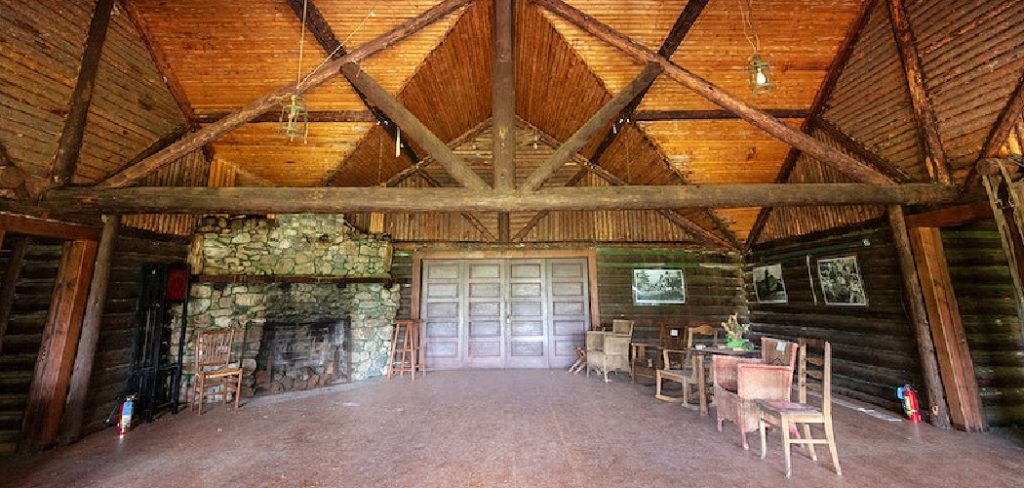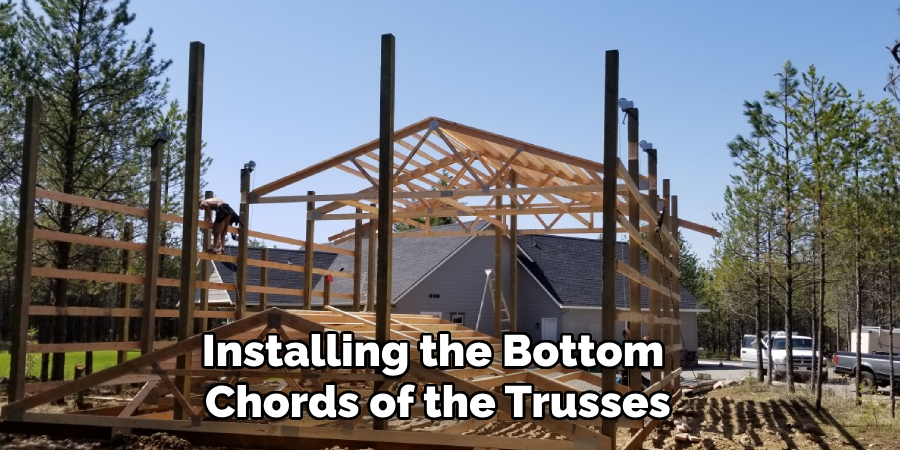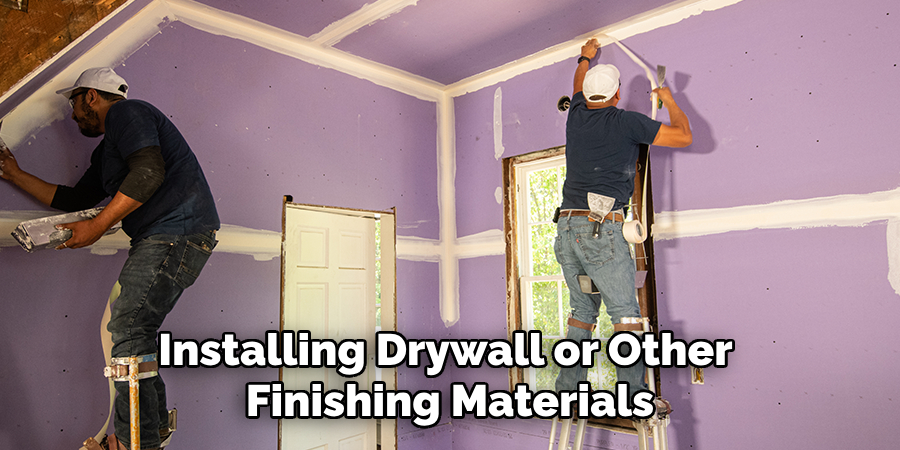Are you looking for an amazing way to give your ceiling a unique and impressive look? Then consider installing trusses! This DIY project is the perfect combination of art, engineering, and creativity.

Installation requires proper planning and careful execution – but once completed it will bring a stunning visual effect that adds style and dimension to any room.
In this blog post, we’ll walk you through the basics of how to vault a ceiling with trusses – so you can begin transforming your space today!
What are Trusses?
Trusses are wooden or metal triangular structures that can support the weight of a roof. They are commonly used in construction to provide stability and prevent roofs from sagging. In recent years, trusses have also become a popular design element for vaulted ceilings. By creating a series of triangles, trusses can evenly distribute the weight of the roof and allow for higher ceiling heights.
Tools and Materials You Will Need to Vault a Ceiling With Trusses
1. Hammer
2. Nails
3. Measuring Tape
4. Level
5. Ladder or Scaffolding
6. Saw (hand saw or circular)
7. Trusses (purchased or custom-made)
Step-by-step Guidelines on How to Vault a Ceiling With Trusses
Step 1: Determine the Design and Measurements
First, you need to decide on the design of your trusses and how they will be spaced. This will depend on the size and shape of your room, as well as personal preference. Some popular truss designs include king posts, queen posts, and scissor trusses. Once you have chosen a design, measure the length and width of your ceiling to determine the number of trusses needed. Be sure to account for any obstructions such as vents or light fixtures.
Step 2: Purchase or Build Trusses
If you are not confident in your carpentry skills, it may be best to purchase trusses from a reputable supplier. However, if you have the necessary tools and experience, building your own trusses can be a cost-effective option. Just be sure to follow the design and measurements carefully. Make sure the joints are secure and the angles are accurate to ensure proper weight distribution.
Step 3: Install the Bottom Chords
Start by installing the bottom chords of the trusses along the length of your ceiling. Use a level to ensure they are straight and secure them with nails. While you can do this step alone, it is recommended to have someone help hold the trusses in place while securing them. This will also speed up the installation process.

Step 4: Install the Top Chords and Bracing
After the bottom chords are in place, begin installing the top chords and bracing. The top chords should be placed on top of the bottom chords, forming a triangular shape. Use braces to secure them together and prevent any shifting. Again, it is recommended to have someone help hold the trusses in place while securing them.
Step 5: Secure Trusses to Walls and Support Beams
Once all the trusses are installed, they need to be secured to the walls and support beams of your home. This helps to evenly distribute weight and provide stability. Use nails or brackets depending on your specific situation. This is another step where it may be helpful to have a second set of hands.
Step 6: Add Finishing Touches
After the trusses are securely in place, you can add any finishing touches such as insulation and drywall. If you want to add lighting fixtures, make sure to plan for them during the design phase so they can be installed without causing damage to your new vaulted ceiling. Make sure to use caution and follow safety guidelines when working around electrical wiring.
Following these guidelines will help you successfully vault your ceiling with trusses and achieve a stunning, unique design element in your home. However, if you are not comfortable completing this project on your own, it is always best to seek professional help. With the right tools, materials, and techniques, you can easily take on this DIY project and transform your space into something truly exceptional.
Additional Tips and Tricks to Vault a Ceiling With Trusses
1. Consider using a professional contractor or builder to help you with the vaulting process, especially if you have no prior experience. They can ensure that the ceiling is properly supported and secured.
2. Before starting any work, make sure to obtain any necessary permits from your local government. This will ensure that your project meets all safety and building codes.
3. If you plan on adding new windows or skylights as part of your vaulted ceiling, consider their placement carefully. You want to avoid blocking natural light or creating awkward spaces in the room.
4. Keep in mind that vaulting a ceiling can also impact the heating and cooling efficiency of your home. It may be necessary to install additional insulation or upgrade your HVAC system to accommodate the increased volume of the room.
5. If you’re working with an existing roof truss system, be aware that not all trusses are designed to be vaulted. Consult with a structural engineer to determine if your trusses can support the added weight and stress of a vaulted ceiling.

6. When installing drywall or other finishing materials on a vaulted ceiling, consider using scaffolding or a drywall lift to safely reach higher areas. Always prioritize safety when working at heights.
7. Remember to factor in extra costs for materials and labor when budgeting for a vaulted ceiling project. The increased complexity of the design may require more time and resources than a traditional flat ceiling.
8. Finally, don’t forget about lighting options! Vaulted ceilings offer unique opportunities for creative lighting fixtures and designs. Consider incorporating dimmable recessed lights or decorative pendant lights to enhance the space.

Following these additional tips and tricks can help ensure a successful vaulted ceiling project with trusses. With proper planning, professional assistance, and safety precautions, you can transform any room with a stunning and functional vaulted ceiling. Happy building!
Safety Precautions Need to Be Followed for Vaulting a Ceiling With Trusses
1. First and foremost, it is important to wear proper safety gear such as a hard hat, safety glasses, and gloves to protect yourself from any potential hazards.
2. Before starting the process of vaulting a ceiling with trusses, it is crucial to ensure that the trusses are structurally sound and properly installed. Any damaged or improperly installed trusses should be fixed or replaced before proceeding.
3. It is recommended to have at least two people working on vaulting a ceiling with trusses. This will not only make the process more efficient but also provide an extra set of eyes for safety precautions.
4. Make sure all electrical wires and plumbing pipes that may be running through the existing ceiling are safely relocated before beginning work on vaulting the ceiling.
5. It is important to have a clear plan and layout of the vaulted ceiling before starting any work. This will ensure that all necessary materials are on hand and the process is carried out smoothly.
6. When working with trusses, it is crucial to follow the manufacturer’s instructions and specifications. Trusses are designed to support specific weights and loads, so altering or modifying them can compromise their structural integrity.
7. Never cut or alter any truss without consulting a professional first. Trusses play a crucial role in supporting the roof structure, and any modifications made without proper knowledge or expertise can lead to serious safety hazards.
Following these safety precautions will help ensure a smooth and safe process of vaulting a ceiling with trusses. It is important to always prioritize safety when working on any home improvement project, especially one that involves altering the structural elements of the house. If you are unsure about any steps or procedures, it is always best to consult a professional for guidance and assistance. So, be cautious and diligent in your approach to ensure a successful and safe outcome!
Benefits of Vaulting a Ceiling With Trusses
1. One of the major advantages of vaulting a ceiling with trusses is the significant increase in space. By raising the ceiling height, you can create more room for storage or living areas. This can also make a small room feel more spacious and open.
2. Vaulted ceilings with trusses can add a touch of architectural interest to any space. They create visual appeal and add dimension to the room, making it feel more inviting and unique.
3. With a higher ceiling, there is improved air circulation and natural lighting in the room. This can make the space feel brighter and more airy, creating a more comfortable living environment.
4. Vaulting a ceiling with trusses can also increase the value of your home. It adds aesthetic appeal and improves livable space, which can be attractive to potential buyers if you ever decide to sell your house.
5. Truss systems are often lightweight and easy to install, making vaulting a ceiling with trusses a relatively quick and cost-effective home improvement project.
These are just a few of the benefits of vaulting a ceiling with trusses. It can be a great way to add value and functionality to your home while also giving it a unique and visually appealing touch. So, if you’re looking for ways to enhance your living space, consider vaulting your ceiling with trusses as an option!

Conclusion
Knowing how to vault a ceiling with trusses can be a valuable skill for any homeowner looking to improve their living space. However, it is important to prioritize safety and follow proper procedures to ensure a successful and safe outcome.
By wearing proper safety gear, ensuring trusses are structurally sound, and following the manufacturer’s instructions, you can successfully vault your ceiling with trusses and enjoy the benefits of increased space, visual appeal, and improved lighting and air circulation. So, consider this home improvement project as an option for enhancing your living space! Happy vaulting!
